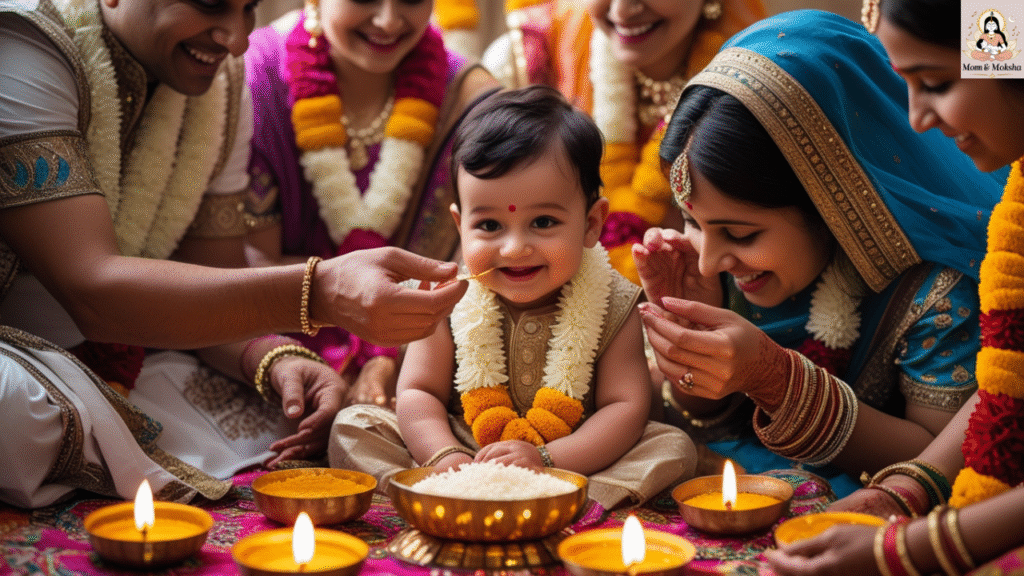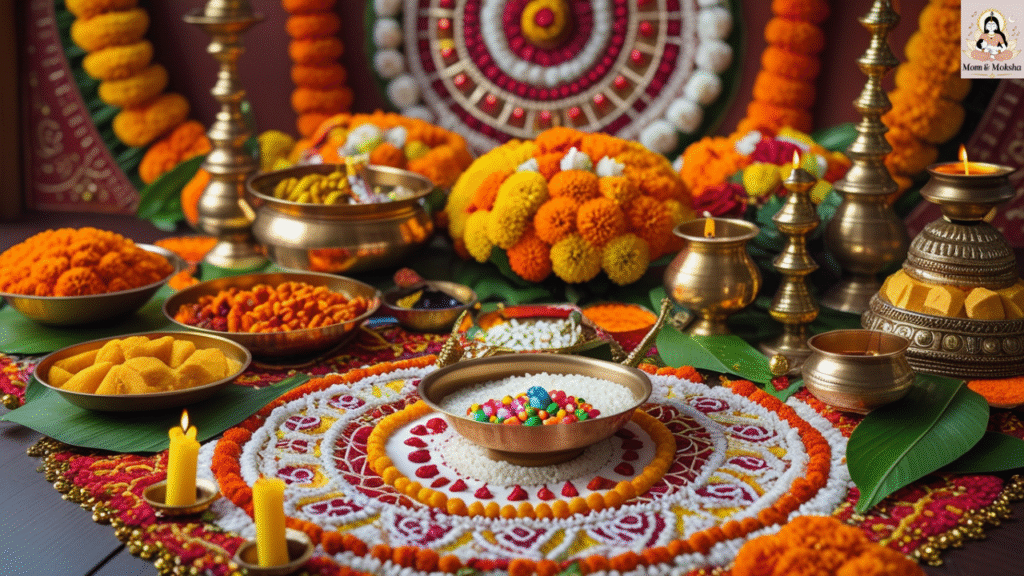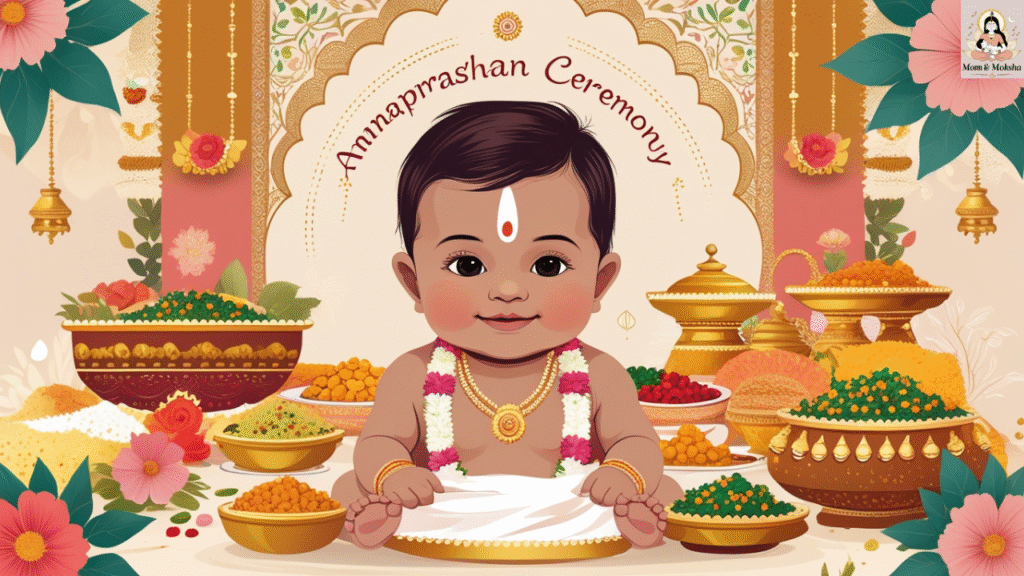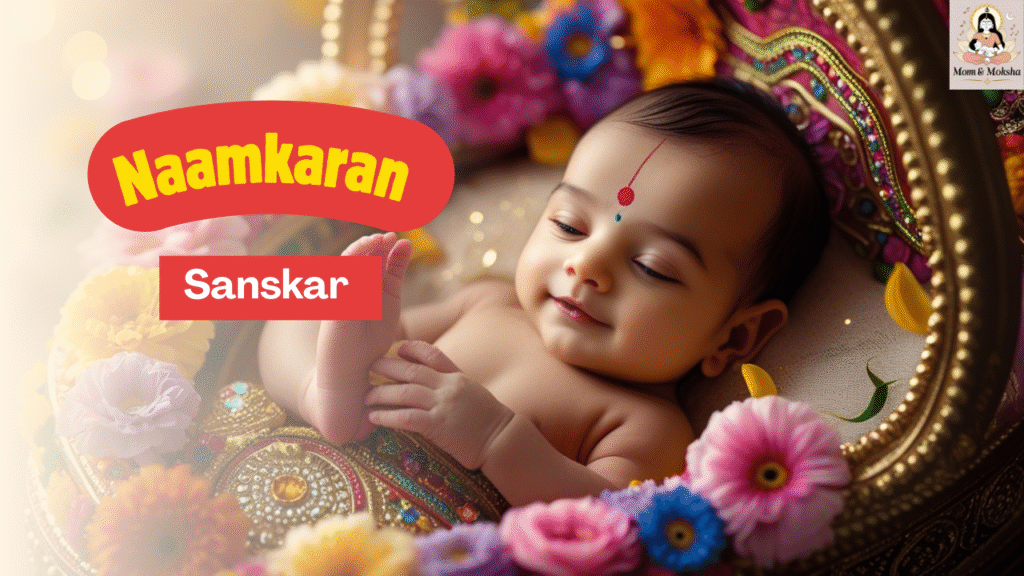🌿 Introduction
Welcoming a baby into the world is a sacred journey filled with rituals and celebrations that mark important milestones in their early life. In Sanatan Dharma, every stage of a child’s growth is honored through Sanskars (sacraments), and one of the most cherished among them is the Annaprashan ceremony, also known as the rice ceremony or first rice ceremony.
Annaprashan is a beautiful tradition where a baby is introduced to solid food, usually rice, for the very first time. This sacred ritual typically takes place when the baby is around six months old, though the timing may vary depending on regional customs, family traditions, and whether the ceremony is for a baby boy or baby girl.
The ceremony goes far beyond simply feeding rice — it is believed to bless the child with good health, intelligence, prosperity, and a long life. Families celebrate it with great joy, inviting loved ones, preparing special food items, decorating the home or temple, and performing rituals passed down through generations.
Like the Naamkaran Sanskar (baby naming ceremony), Annaprashan holds deep spiritual and cultural value, marking another important step in the baby’s journey of growth and connection with Sanatan Dharma.
In this blog, we will explore everything you need to know about the Annaprashan ceremony — from the rituals, food items, decoration, invitation cards, and quotes to the ancient scriptural references that highlight its true significance. Whether you are planning your baby’s Annaprashan or simply curious about this sacred tradition, this guide will walk you through the details in depth.
🌿 What is Annaprashan?
The word Annaprashan comes from Sanskrit:
- Anna = food/grain (especially rice)
- Prashan = feeding or consumption
Thus, Annaprashan literally means feeding grains for the first time. It is traditionally the first time a baby eats solid food, usually rice or kheer. This ritual not only blesses the child with health and prosperity but also marks their formal introduction to family food and culture.
👶 Annaprashan Ceremony for Baby Boy (and Baby Girl)

Food has always been central in our traditions—from the baby’s first grains in Annaprashan to the sattvic meals observed during Navratri fasting, each ritual reminds us that food is both nourishment and devotion. The Annaprashan ceremony is performed for both boys and girls, though the timing and certain customs may differ slightly based on regional traditions. In most Hindu households:
- For a baby boy → Annaprashan is usually performed in the sixth month after birth (when the child is about 180 days old).
- For a baby girl → Annaprashan is often performed in the fifth or seventh month, depending on family customs and the advice of the family priest (purohit).
👉 The difference in timing is linked to ancient beliefs about the development of boys and girls, but today, parents often choose the month based on the baby’s health, astrological recommendations, or family convenience.
Regardless of gender, the essence remains the same: seeking blessings for the child’s long life, good health, and wisdom.
✨ Significance for Baby Boy
- The ritual symbolizes strength, courage, and prosperity for the boy’s future.
- In many families, the baby boy is dressed in traditional attire like a dhoti-kurta, with a smalltilak on the forehead.
- Elders feed him rice with prayers for valor, intelligence, and success in dharma and worldly life.
🌸 Significance for Baby Girl
- Annaprashan for girls is seen as an auspicious step toward grace, beauty, nourishment, and wisdom.
- The baby girl is often dressed in a small lehenga, saree, or frock in bright colors like red, yellow, or green — colors considered auspicious in Hindu culture.
- Elders bless her with wishes for long life, health, and devotion.
🙏 Annaprashan Rituals & Procedure
The Annaprashan ceremony, like other Hindu sanskars, follows a series of rituals that carry deep spiritual significance. While customs may vary across regions, the essence remains the same — to bless the child as they begin their journey of eating solid food.
🕉️ 1. Auspicious Date & Time (Muhurta)
- Families usually consult a priest or astrologer to determine the right muhurta (auspicious timing) for the ceremony.
- The baby’s birth star, horoscope, and health are taken into account.
- Traditionally, boys are initiated in the 6th month, while girls in the 5th or 7th month.
🔥 2. Purification Rituals
- The ceremony begins with a Ganesha puja to remove obstacles.
- Some families also perform a havan (sacred fire ritual) or chant Vedic mantras for blessings.
- The baby is bathed, dressed in new traditional clothes, and adorned with a tilak on the forehead.
🍚 3. Offering to Deities
- Before feeding the baby, the prepared rice or kheer (sweetened rice pudding) is offered to the family deity, Lord Vishnu, or Goddess Annapurna.
- This step sanctifies the food and symbolizes divine nourishment.
👶 4. First Feeding (Prashan)
- The father, grandfather, or maternal uncle traditionally feeds the first spoon of rice to the baby.
- In many regions, elders take turns feeding small morsels (symbolic, not large amounts), blessing the child each time.
- The act is often accompanied by chanting shlokas or mantras for health, wisdom, and longevity.
🌿 5. Blessings from Elders
- After the feeding, relatives and guests bless the baby by placing rice, flowers, or gifts in front of them.
- Some families perform a small ritual where different symbolic items (books, jewelry, toys, coins) are placed before the baby, and whichever the baby touches first is believed to reflect their future inclination — towards learning, wealth, or devotion.
🎉 6. Celebration & Feast
- The ceremony concludes with a family meal or community feast, where special food items are prepared and shared.
- Guests are served traditional delicacies, making it both a spiritual and social celebration.
✨ Symbolic Meaning of Rituals
- Rice → Life, nourishment, fertility.
- First Feeding by Elders → Continuity of tradition and blessing of ancestors.
- Offerings to Deities → A reminder that food is sacred and comes from divine grace.
- Blessings Ritual → A way to align the child’s future with family values and dharma.
🍲 Annaprashan Ceremony Food Items
The Annaprashan ceremony is centered around food, not just for the baby but also for the community. The baby takes a tiny spoonful of rice (anna), while family and friends share a festive meal that symbolizes abundance and blessings. The choice of food holds both cultural and health significance.
👶 Baby’s First Food
Traditionally, the baby is fed:
- Plain soft rice – Symbol of nourishment and life.
- Kheer (sweet rice pudding) – Made with milk, rice, sugar/jaggery, and sometimes cardamom or saffron, symbolizing sweetness in life.
- In some households, a tiny drop of ghee is added for strength and digestion.
- For the baby, only a very small quantity is given — just enough for the ritual.
⚠️ Parenting Note: Annaprashan is a symbolic ritual. Doctors recommend continuing breastmilk or formula as the main nutrition for babies under one year. Consult your pediatrician before starting solids. “Alongside celebrating milestones like Annaprashan, learning tips for newborn care
🍴 Food for Guests (Festive Meal)
The feast after Annaprashan is an important way of celebrating with loved ones. The menu often reflects regional traditions:
🔸 North India
- Puri / Kachori
- Chole or Paneer Curry
- Rice & Dal
- Kheer / Halwa
🔸 Bengal (Mukhe Bhaat)
- Rice with ghee
- Fish curry (for non-vegetarian families)
- Shukto (mixed veg curry)
- Mishti doi (sweet curd) and sandesh
🔸 Kerala (Choroonu)
- Red rice (matta rice)
- Sambar, Avial, Thoran (veg dishes)
- Payasam (sweet pudding)
- Banana chips and pickles
🔸 Tamil Nadu / Andhra
- Steamed rice with ghee
- Rasam, Sambhar, Poriyal
- Payasam or Kesari
- Banana served as traditional plate
🌸 Symbolism of Annaprashan Foods
- Rice → Fertility, nourishment, and prosperity.
- Milk & ghee → Purity and strength.
- Sweets (kheer, payasam) → Wishing the child a sweet and joyful life.
- Regional dishes → A reminder of family heritage and cultural roots.
💡 Modern Touch
Many families today also include:
- Customized Annaprashan cakes decorated with rice-bowl or baby motifs.
- Finger food counters for guests.
- Healthy options like fruit platters and millet-based sweets.
This blend of traditional offerings with modern celebration makes the Annaprashan feast both sacred and memorable.
📖 Scriptural References to Annaprashan Ceremony
The Annaprashan ceremony is not just a cultural tradition but one of the 16 Shodasha Samskaras (sacraments) prescribed in Sanatan Dharma to sanctify every stage of human life. Its roots are deeply embedded in the Vedas, Grihya Sutras, and Smritis, showing its spiritual significance across time.
🕉️ Vedic Foundations
Taittiriya Samhita (Krishna Yajurveda) – Mentions that food (anna) is the very basis of life and strength. Feeding rice to a child for the first time symbolizes the child’s entry into the world of sustenance.
Rigveda – Praises food as divine and emphasizes that nourishment is essential for spiritual and physical growth.
📜 Grihya Sutras
The Grihya Sutras (domestic ritual texts) list Annaprashan as an essential samskara to be performed between the 5th and 7th month of life.
The ritual includes prayers for the baby’s health, intelligence, and long life, with offerings to Agni (fire god) and the household deities.
📖 Manusmriti
Manusmriti 2.27 highlights Annaprashan as one of the earliest duties of parents toward the child, ensuring their integration into dharmic living.
The text emphasizes that the ceremony should be performed with grains that are pure and sanctified.
📚 Garuda Purana
The Garuda Purana notes that Annaprashan ensures not only physical nourishment but also mental sharpness and spiritual readiness.
It describes the ceremony as invoking blessings from ancestors and gods, connecting the child to family lineage and dharma.
🌺 Spiritual Purpose in Scriptures
Rice (Anna) is considered sacred — an offering to gods, ancestors, and humans alike. Introducing rice to the child marks their first participation in the universal cycle of nourishment.
Annaprashan is seen as a prayer to Annapurna Devi (Goddess of Food) to bless the child with abundance and to ensure that they never face hunger in life.
Feeding by elders symbolizes continuity of tradition, where the wisdom and blessings of past generations flow into the child’s future.
🎀 Annaprashan Decoration & Invitation Ideas

While the Annaprashan ceremony has deep spiritual meaning, it is also a joyful family celebration. Parents often mark the occasion with beautiful decorations and personalized invitations that make the ceremony memorable for loved ones.
🌸 Annaprashan Decoration Ideas
🕯️ Traditional Decoration
Mandap Setup – A small mandap (sacred area) decorated with flowers, mango leaves, and banana stalks where the puja and feeding take place.
Rangoli or Alpana – Designs at the entrance and near the puja space to welcome guests.
Flowers & Diyas – Marigold, jasmine, or roses strung together with oil lamps for an auspicious setting.
Rice & Kalash – Symbolic items placed around the venue to represent prosperity.
🎉 Modern Decoration Themes
Balloon Arches – In pastel or golden tones with “First Rice Ceremony” or “Mukhe Bhaat” written on banners.
Photo Booths – Backdrops with baby’s name and theme-based props (e.g., rice bowl, spoon, baby motifs).
Floral Backdrops – Artificial flower walls or garlands combined with fairy lights for photography.
Personalized Decor – Banners that say “Annaprashan of [Baby’s Name]” with date and quotes.
💡 Tip: Mix traditional and modern elements — for example, a flower-decorated mandap for rituals, and a balloon setup for the party area.
✉️ Annaprashan Invitation Card Wording
Invitations set the tone for the ceremony. You can keep them traditional, modern, or digital depending on your guest list.
🪔 Traditional Invitation Cards
- Designs with Kalash, Om, Swastika, or Rice motifs.
- Sanskrit shlokas or mantras like “Anna Brahma Swaroopam” (Food is divine).
- Printed on eco-friendly handmade paper for authenticity.
📱 Modern / Digital Invitations
- E-invites or WhatsApp invites with pastel themes, baby photos, or cartoon rice bowls.
- Animated cards with playful fonts saying, “Join us for [Baby’s Name]’s First Rice Ceremony.”
- Templates available on Canva, Etsy, or Indian card websites for customization.
🎀 Invitation Wording Examples
A beautifully designed card sets the tone. Some wording ideas:
“With divine blessings, we invite you to join us for the Annaprashan Ceremony of our beloved son/daughter [Baby’s Name]. Come share the joy as we celebrate their first bite of rice.”
Include:
- Date, time, and venue
- Baby’s name
- RSVP/contact details
Symbols like Om, baby footprints, rice bowls, or floral borders add charm.
🌿 Photography & Keepsakes
Many families now also arrange:
- A themed cake with rice motifs.
- Photography/videography to capture the feeding moment.
- A guest wish book where loved ones write blessings and quotes for the baby.
💬 Annaprashan Ceremony Quotes & Captions
The Annaprashan ceremony is not only a sacred family ritual but also a joyous celebration that parents love to share with loved ones. Whether it’s for an invitation card, Instagram caption, or family scrapbook, here are some meaningful and creative quotes you can use.
✨ Traditional & Spiritual Quotes
- “Food is divine — Anna Brahma Swaroopam. May our child always be blessed with health and abundance.”
- “With the first grain of rice, we pray for wisdom, strength, and a prosperous life for our little one.”
- “As our baby takes the first step into the world of food, may Lord Vishnu and Goddess Annapurna bless this journey with sweetness.”
- “Just as grains nourish the body, may dharma nourish the soul of our child forever.”
🌸 Heartfelt Parent Quotes
- “From milk to rice, from tiny steps to big dreams — today marks a special milestone for our baby.”
- “The first spoon of rice is more than food, it’s a bowl full of blessings.”
- “Our little one’s journey of growth begins with this sweet grain of love.”
- “Every grain is a prayer, every blessing a gift — join us in celebrating our baby’s Annaprashan.”
📸 Social Media Captions (Instagram/Facebook/WhatsApp)
- “Tiny bites, big blessings. 🍚✨ #Annaprashan #RiceCeremony”
- “First spoon of rice, endless love ahead. 💕👶 #FirstRiceCeremony”
- “Celebrating tradition, love, and food — Annaprashan vibes only. 🌸🔥”
- “From milk to rice, our baby’s journey of nourishment begins today. 🙏🌿”
- “A bowl full of rice, a lap full of love. 💖 #BabyMilestone”
💌 Invitation Captions
- “Our baby is ready for the first taste of rice. Join us as we celebrate this sacred milestone!”
- “Bless our child as they take their first spoon of food at the Annaprashan ceremony.”
- “The joy of watching our baby’s first bite is doubled when shared with family and friends. You are invited!”
Quotes
- “Food is the gift of life — today we bless our child with their first bite of rice.”
- “May this first spoonful of rice bless our baby with abundance, health, and wisdom.”
Captions
- “Tiny hands, big blessings 🌸 Our baby’s first rice ceremony today!”
- “From milk to grains — the sacred journey begins. #Annaprashan”
- “Celebrating traditions, one spoonful at a time 🍚💛”
🌍Regional Variations | Annaprashan Traditions Across India
- Bengali families call it Mukhe Bhaat (feeding rice in the mouth) and often make it a grand celebration with extended relatives and a festive feast. The baby is dressed in silk clothes, usually dhoti-kurta for boys and saree/frock for girls.
A grand thali of rice, fish (in non-vegetarian families), sweets like rosogolla and mishti doi is prepared. The maternal uncle traditionally feeds the first bite. Decorations often include alpana designs on the floor, marigold flowers, and festive backdrops. - In Kerala, it is called Choroonu and is performed at the Guruvayur temple, where thousands of families gather each year. Babies are fed red rice (matta ari) by priests or family members. Decorations are simple — temple lamps, banana leaves, and flowers — focusing on spiritual purity rather than grandeur.
- In North India, the ceremony is often performed at home with a small havan (sacred fire ritual). Babies are fed sweetened rice or kheer by the father or grandfather. Decorations include kalash, mango leaves, marigold garlands, and in modern settings, balloon or theme setups. A festive feast with puri, paneer, halwa, and kheer is served to guests.
- In South India, especially Tamil Nadu and Andhra Pradesh, Annaprashan includes offering rice to deities before feeding the baby. Known as Annaprasana or Choroon. The ritual is performed at home or temple, often during auspicious nakshatras. Food includes rice, rasam, dal, and payasam. Decorations use kolam (rangoli) at entrances, and flowers around the puja altar.
👉 You can read my full guide on Naamkaran Sanskar (Baby Naming Ceremony) to see how Annaprashan beautifully follows as the next samskara in a baby’s journey.
❓ FAQs on Rice Ceremony
Q. What is the best time for Annaprashan?
A. Traditionally the 6th month for boys and 5th/7th month for girls, but consult your family priest and doctor.
Q. Can Annaprashan be done at home?
A. Yes, it can be done at home, in a temple, or in a banquet hall, depending on family preference.
Q. What if the baby refuses to eat?
A. It’s okay — Annaprashan is symbolic. Even touching the lips with rice is considered auspicious.
Q. Is a priest necessary?
A. Ideally yes, but some families do a simple puja with prayers and blessings.
🌸 Conclusion
The Annaprashan ceremony is more than just the baby’s first bite of rice — it is a sacred samskara that blesses the child with nourishment, strength, and prosperity. Rooted in ancient scriptures yet celebrated joyfully in modern homes, it reminds us of the divine role food plays in our lives.
As parents, these milestones — from Naamkaran Sanskar (baby naming ceremony) to Annaprashan — weave together spiritual values and family memories that last a lifetime. As parents, witnessing your little one’s first spoon of rice is a deeply emotional and spiritual moment. It reminds us that food is not just nourishment for the body but also prasada (divine blessing) that sustains life. By celebrating Annaprashan, families pass down timeless traditions while creating modern memories that last a lifetime.
May every grain your child eats bring health, wisdom, and happiness — and may this beautiful tradition continue to bless generations to come. 🙏🌿
Have you celebrated Annaprashan for your child? Share your experiences in the comments — your story might inspire another mom on her journey 🌿✨



